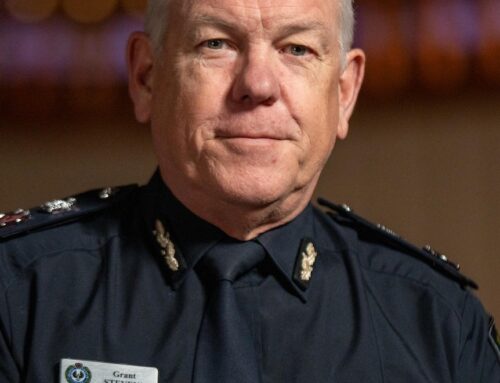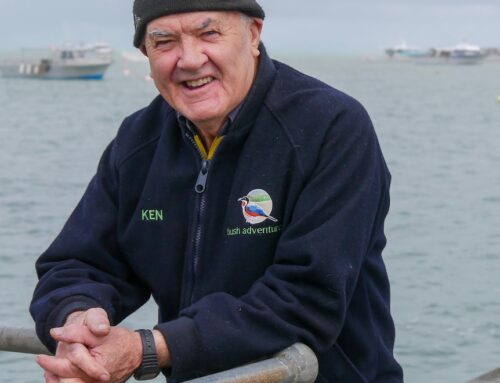The fire began just outside of Lithgow, New South Wales.
The combination of warm weather and dry winds in September 2013 had made the Blue Mountains grassland unusually dry for that time of year.
That’s how one spark on October 13 grew into a devastating 25-kilometre-long blaze by the following day.
Over the next fortnight, the fire continued to grow. Eventually it would be joined by other blazes across the northern Greater Blue Mountains region.
By October 25, more than 65,000 hectares of bushland and nearly 200 homes had been engulfed by the infernos.
The 2013 Blue Mountains bushfires are still regarded among the worst Australian fires in recent memory.
Yet despite the devastation, this disaster may have revealed a way to help save koalas from extinction, conservationist Kellie Leigh tells ABC RN’s Big Ideas.
Fighting to save koalas
Koala populations have been in decline in Australia in recent years.
In 2020, the Australian Koala Foundation estimated that there were no more than 57,920 koalas still in the wild.
Rising temperatures, widespread chlamydia outbreaks, land clearing and urban development are just some of the threats koalas currently face, although the problem stretches back more than a century.
In the 1920s, the koala conservation movement began in earnest after hunting them for their fur almost sent the iconic creature to extinction.
One attempt to help boost populations at that time was relocating koalas.
Between 1923 and 1925, 18 koalas from Victoria’s French Island were relocated to South Australia’s Kangaroo Island – an island then without a native koala population.
By 2019, the estimated population of these koalas was around 50,000.
Yet, while these conservation efforts lifted koala numbers, Dr Leigh says significant gaps in our knowledge have impacted long-term success.
For example, she points to the lack of research on how species’ differences impact translocation.
“We know you wouldn’t shift koalas from [Victoria to Queensland] because they just can’t deal with the different climates,” Dr Leigh says.
But she says we don’t know enough about potential borders within local populations and conservation sites.
“If there’s a population in Victoria, can you move it 100 kilometres?”
If conservationists are relocating koalas, targeting habitats or building corridors between regions, “you really need that information”, Dr Leigh says.
Not having the right information can have devastating consequences.
For example, in 2018 one Queensland koala translocation program was found to have a mortality rate of 42 per cent.
The other problem with relocating small populations is that it can impact genetic diversity.
A 2009 study of Kangaroo Island koalas found that the population possessed low genetic diversity. Koala inbreeding can result in conditions like malformed jaws, infertility and less resistance to diseases. And almost one in five male koalas had testicular abnormalities.
“When you’ve got animals that are so similar, it just takes a new disease to go through, and suddenly all of those animals are susceptible,” Dr Leigh says.
‘Turned on its head’
In October 2013, as those fires raged through the Blue Mountains and Dr Leigh watched the devastation wreaked on local flora and fauna, she realised there were wild koalas she didn’t know about in that area.
“There hadn’t been records [of wild koalas] for up to 70 years — since the fur trade — at that time,” Dr Leigh says.
Intrigued, she moved to the region to survey these wild koala populations, and she set up the not-for-profit conservation group Science for Wildlife.
Historically, wild koalas weren’t thought to live in the Blue Mountains because of its soil type.
“People look at the Blue Mountains and think it’s sandstone country. There’s either not any koalas here, or there’s not enough for this area to be important,” Dr Leigh says.
“But the more we find out about koalas here, the more that story is turned on its head.”
The Science for Wildlife team got to work studying the Blue Mountains’ wild koalas.
In 2018, the group reported that Blue Mountains koala populations were the most genetically diverse recorded.
Then in 2022, Dr Leigh and her team came across a new colony of koalas in the Blue Mountains that were free of chlamydia.
The disease can result in infertility and blindness and it’s a blight on the national koala population. For example, a 2019 study found that 60 per cent of one Queensland koala colony tested positive for the sexually transmitted infection.
This group was chlamydia-free.
All these discoveries are exciting in their own right, but Dr Leigh says they point to a more positive outlook for the at-risk species.
A national stronghold
But in January 2020, the region took another hit during the summer bushfires that raged across New South Wales.
Up to 80 per cent of these bushfires burned through the Greater Blue Mountains area.
According to a report from the World Wild Fund, almost 3 billion animals in the Greater Blue Mountains area perished during these summer bushfires, including more than 60,000 koalas.
The bush has recovered slowly from the blazes. Dr Leigh says the upper Blue Mountains region may still be a “national stronghold for the species”.
She describes the region as a climate refuge for koalas, somewhere that is unaffected by changes in the climate, like rising temperatures, extreme drought and heat waves.
“A climate refuge is an area that’s got enough variation in it, or something different about it, that it can buck that trend.
“So aside from the westerlies that come through the mountains, it’s generally 10 degrees cooler on the upper mountains. We’ve got higher rainfall [and] we’ve got steep gullies that, on a really hot day, are still going to have cool temperatures in there.”
Just as importantly, Dr Leigh points out that the 10,000 square kilometres of the Greater Blue Mountains area is a World Heritage-listed site, so this area would be protected from urban development.
This is good news because one of the main reason for declining koala numbers is a loss of habitat, as well as attacks from dogs and being hit by cars.
“We want to reduce those risks,” Dr Leigh says.
“So effective conservation basically has to occur within the protected area.”
But Dr Leigh says if there’s an increase in the frequency and intensity of fires like those in 2020, places like the Blue Mountains may not continue to be the biodiversity refuges they’re intended to be.
“It’s not what the Australian landscape has adapted to. And so that has to be managed.”
‘A story of hope’
As the climate continues to shift around the world, Dr Leigh says there are still many questions about how koalas can be protected. For example, what habitats need to be protected, which habitats recover well post-fire, and what a fire refuge for koalas looks like?
While these questions don’t have immediate answers, discoveries in the Blue Mountains give her hope for the future of koalas and their wider ecosystems.
“One of the powerful things about working with koalas … [is] they are a good flagship species, because they utilise such a range of different eucalypt habitats,” she says.
“So to protect them, you’ve got to protect eucalypt forests, and that benefits a range of other species as well.”
Dr Leigh says there is a growing consensus among Australians that we need to protect nature and our native species.
“There’s certainly a growing movement. And now that we know that places like the World Heritage area — particularly for koalas — are important, that is a story of hope.”
RN in your inbox
Get more stories that go beyond the news cycle with our weekly newsletter.
Posted , updated




